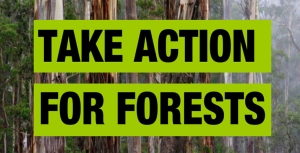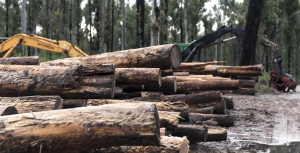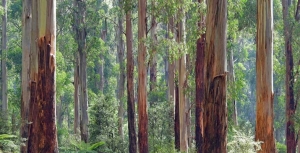Displaying items by tag: logging
Take action for forests
We recently wrote about the urgency of a decision to cease logging in NSW native forests. Logging cannot continue in public native forests without pushing the koala, greater glider, coastal emu and many more forest-dependent wildlife species much further towards extinction. Illegal logging practices, endangered species habitat destruction and totally inadequate pre-logging wildlife surveys have become the norm for Forestry Corporation. Under current rules, the volume of logs taken is considered more important than endangered wildlife.
There is now a great opportunity to act to cease native forest logging in NSW. The NSW government is developing a Forest Industry Assessment Plan that will shape the future of forestry in NSW. Ending native forest logging is one of the options being considered. There is a call for submissions to the Independent Forestry Panel that will assess the sustainability of current and future forestry operations.
This is a historic opportunity to finally win this long fought for campaign. Take action by making a submission by 13 October to the Independent Forestry Panel. Click here for the Nature Conservation Council’s submission guide and further information.
Ending native forest logging would help Australia’s climate goals much more than planting trees
What is being overlooked in current international climate policy under the Paris Agreement is the crucial role of biodiversity in maintaining healthy ecosystems and their integrity, which keeps carbon stored in forests, not the atmosphere. Healthy ecosystems are more stable and resilient, with a lower risk of trees dying and lower rates of carbon emissions.
The way we currently count carbon stores risk creating incentives to plant new trees rather than protect existing forests. Yet old-growth forests store vastly more carbon than young saplings, which will take decades or even centuries to reach the same size.
Can ending native forest logging help the climate?
We’ll need to go further and ban logging in all native forests in Australia to help meet our net-zero emissions target, while meeting timber demand from better-managed and increased plantations.
Stopping native forest logging avoids the emissions released when forests are cut and burned. It would also allow continued forest growth and regrowth of previously logged areas, which draws down carbon from the atmosphere and increases the amount held in the forest ecosystem.
The natural biodiversity of our native forests makes them more resilient to external disturbances such as climate change. These forests have larger and more stable carbon stocks than logged areas, newly planted forests and plantations.
If we compare forests protected for conservation with those harvested for commodity production in the Victorian Central Highlands, research shows conservation delivers the greatest climate benefits through continued forest growth and accumulating carbon stocks.
There are growing calls to create the Great Forests National Park to the north and east of Melbourne, which would protect a further 355,000 hectares and more than double protected forests in the Central Highlands.
Net zero: deep, rapid, sustained cuts needed
The world’s nations are aiming to reach net zero by mid-century. Meeting this target will require deep and rapid cuts in carbon dioxide emissions as well as pulling carbon out of the atmosphere into land sinks, especially forests.
The land sector is unique in that it can be both a source (logging, agriculture) and a sink (forest regrowth, for instance) for carbon. The natural way forests take up carbon can be increased through natural regrowth or plantations.
Unfortunately, the current approach, based on IPCC guidelines, to counting this type of natural carbon storage can lead to perverse outcomes.
The carbon sink from forest regrowth only counts towards the “removals” part of net zero when it results from changes we make, such as ending native forest logging. It doesn’t count if it’s regrowth after a natural event such as a bushfire. It’s important to count only human-induced changes in our climate targets.
Tree planting, on the other hand, can be counted towards net-zero targets, despite the fact that newly planted trees will take centuries to sequester as much carbon as found in an old-growth forest.
This type of accounting – known as flow-based accounting – can mean a premium is placed on planting and maintaining young forests with high carbon uptake rates, overlooking the substantial benefits of protecting larger trees in native forests.
That is, this approach favours carbon sequestration (the process of taking carbon out of the atmosphere and storing it in wood) over carbon storage (the total carbon stocks already contained in a forest).
A comprehensive approach to forest carbon accounting would recognise both flows of carbon (as sequestration) and carbon stocks (as storage) contribute to the benefits that native forests offer for reducing emissions.
Carbon accounting needs more clarity
This becomes a problem when forests and fossil fuels are included in a net accounting framework, such as the one used in Australia’s national greenhouse gas inventory.
In net accounts, emissions (from fossil fuel and land sectors) within a year are added to removals, which includes the sequestration of carbon into forests and other ecosystems.
Because this type of accounting only counts the flows of carbon – not existing stocks – it omits the climate benefits of protecting existing forests, whose stored carbon dwarfs the amount Australia emits from fossil fuels each year.
But if we separated out targets for the fossil fuel and land sectors, we could properly treat forest carbon stocks as an asset, giving us incentives to protect them.
Another problem with net accounting is it treats all carbon as equivalent, meaning a tonne of carbon sequestered in trees compensates for a tonne of carbon from burned fossil fuels. This has no scientific basis. Carbon dioxide emissions are effectively permanent, as the buried carbon we dig up and burn stays in the atmosphere for millennia, while carbon in trees is temporary in comparison.
As trees grow, their carbon storage compensates for earlier logging and clearing emissions, which is an important climate benefit. But we’re not comparing apples and apples – forest carbon doesn’t compensate for fossil fuel emissions.
Logging bans are important – but no substitute for ending oil and gas
While ending the clearing and logging of native vegetation is vital for both climate and biodiversity, it’s no substitute for preventing emissions from fossil fuels.
To make this clearer, we must urgently set separate targets for emissions cuts for fossil fuels and increased carbon removal in the land sector. This will ensure phasing out fossil fuel use is not delayed by planting trees, and that the carbon stocks of biodiverse and carbon-dense native forests are protected.
Kate Dooley, Research Fellow, School of Geography, Earth and Atmospheric Sciences, The University of Melbourne
This article is republished from The Conversation under a Creative Commons license. Read the original article.
Let’s end native forest logging
NSW has two million hectares of public native forests along the coast. They are home to diverse wildlife and myriad forest ecosystems. Currently the primary use of these forests is timber production. Native forest logging takes place under regional forest agreements that are supposed to provide for ‘sustainable forest management’. Yet there are numerous examples of scarce hollow bearing trees and trees that provide koala habitat being felled. Forestry Corporation has been fined by the EPA multiple times for breaching forestry rules.
The loss of large areas of forest during the Black Summer bushfires has made the habitat provided by these forests all the more critical. Several species have been added to the threatened list since the fires, such as the koala, gang-gang cockatoo and greater glider.
These forests are also important for filtering water, slowing floodwater flows and storage of carbon. Forests can also provide opportunities for tourism and recreation both active and passive, such as bike riding, sightseeing and bushwalking.
Petition signed by over 21,000
In an attempt to end native forest logging a petition was launched by NSW Young Greens Indigenous Officer Takesa Frank and the Nature Conservation Council. It received more than 21,000 signatures which has forced parliament to respond.
The petition called for the NSW government to:
- develop a plan to transition native forest logging to 100% sustainable plantation forestry by 2024
- in the interim place a moratorium on logging until the regulatory framework is applied in line with the Natural Resources Commission recommendations
- immediately place high conservation value forests into the National Park estate
- immediately ban the use of native forest materials as biomass
The responsible Minister for Agriculture, the Hon Dugald Saunders, was dismissive. He claimed that the views of the 21,000 people who signed the petition are insignificant.
Some of the government’s arguments made in their response can be refuted, for example:
- Cutting down native forests is environmentally sustainable
Response: Current practices are destroying biodiversity such as loss of koala habitat and increasing the number of threatened species.
- Only a minority of people care about the issue
Response: A huge survey commissioned by the forestry industry in 2016 found that 70% of people in cities and 65% in regional areas are against native forest logging.
- Native forest logging is financially viable
Response: This industry is barely making a profit.
- Logging native forests will help overcome the shortage of construction timber
Response: The timber used by the construction industry is almost exclusively plantation pine. Meanwhile our native forests are chipped and shipped overseas for paper products.
- It is better to use local timbers than those from overseas
Response: Illegally logged timber is already banned from being imported to Australia, and many imported products meet the Forestry Stewardship Council (FSC) certification, a standard that NSW Forestry Corporation does not meet, because of its unacceptable impacts on biodiversity.
- Logging native forests employs 20,000 people
Response: The number of jobs is a twentieth of the total the minister claims, at 1,000 jobs across the whole of NSW. There are 20,000 jobs in the sustainable plantation industry
Cost-benefit analysis of the industry In the South Coast
A study by Frontier Economics found that there is economic benefit from ceasing native forest harvesting in the Southern and Eden forest regions of NSW. The economic analysis measures the stream of costs and benefits over a 30 year period to 2051. The net result was a gain of $62 million if the state-owned native forests are no longer harvested.
The report took a simplified approach by restricting the analysis to compare the existing operations with the creation of a mountain bike park. This covered:
- costs: loss of value of harvested wood and construction and maintenance of mountain bike recreation area
- benefits: avoided costs of harvesting wood and processing, value of carbon credits, economic value of recreation
More complex factors were not included such as the value of wildlife saved and visitor tourism apart from mountain biking.
In conclusion, Frontier Economics found that Forestry Corporation NSW’s hardwood business made a normalised profit of $0.4 million in the financial year 2020, and an average normalised profit of $2.3 million over the five years to 2020. This is a very small profit and significantly smaller than the $64 million five year average over the same period earned by their softwood plantation business.
This poor return should be taken in context with the economic benefit from ceasing native forest harvesting and obtaining environmental and recreational services from the forest. This, along with the environmental concerns, has led Victoria and WA to decide to cease logging their native forests and to provide significant financial support to the industry to transition to a greater focus on plantation operations and other sectors of the economy. Now it’s time for NSW to also make the commitment.
Private land forestry
Currently, logging operations on private property in many areas have dual oversight from both the state government and local councils. Local councils have the ability to limit and control logging operations within their region. Just this month the National Party tried to revive the ‘koala wars’ by introducing a bill before the NSW parliament to remove this control. Fortunately several Liberal MPs threatened to vote against the bill and it has been withdrawn.



